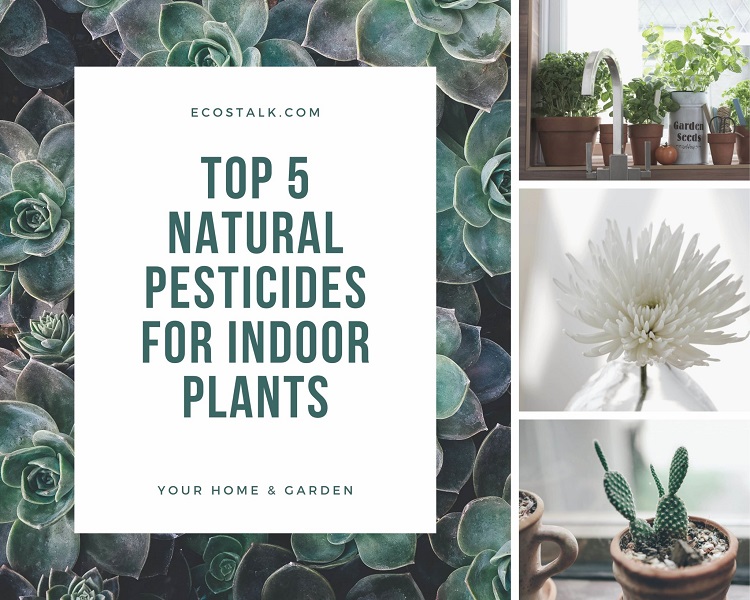Please note that I may earn a small commission from purchases made through product links in this article. As an Amazon Associate I earn from qualifying purchases.
Last updated: May 6, 2023
Using natural pesticides for indoor plants is a tried and tested way to keep your plant collection happy and healthy.
Not only is a natural pesticide often healthy for the plant and you and your family, but it can be very cost-effective and fast-acting.
But how do you know which natural pesticide to choose? Lucky for you we have put together a list of the top 5 natural pesticides for indoor plants.
Top 5 Natural Pesticides for Indoor Plants
1. Insecticidal Soap
Insecticidal soap is one of the most effective natural pesticides for indoor plants on the market, is very convenient to apply, and kills a wide range of pests.
These types of soap are similar to liquid dish soap but far less harsh and toxic than what you would use to clean your dishes.
They are safe to use on most plants including fruits and vegetables, non-toxic to animals and birds, and safe for most good insects.
Suitable to Remove:
Aphids, spider mites, mealybugs, scale crawlers, whiteflies.
How to Use:
Spray the insecticidal soap directly onto the pests, as it is a contact pesticide and works by touching them. It’s not great to prevent pests, because once it dries it no longer works. It may take a few treatments to kill all the bugs (if they are hiding or haven’t hatched from their eggs yet).
Here is an easy-to-use spray-on option:
No products found.
2. Spinosad Soap
Spinosad Soap is another variant of insecticidal soap, which uses a naturally occurring bacteria that kills pests after they eat it. However it is also toxic to bees, so be careful not to apply it to any flowering plants.
Suitable to Remove:
Thrips, caterpillars, leafminers.
How to Use:
Similar to the insecticidal soap above, spray directly onto visible pests on the plant.
You can find also find 2-in-1 spinosad and insecticidal soaps like this from Natural Guard which can kill a wider variety of pests:
No products found.
3. Neem Oil Extract
Neem Oil is a natural pesticide extracted from Neem tree seeds. It is very effective against a wide variety of pests, especially if they are not fully grown yet.
It works by smothering and suffocating the insect.
Suitable to Remove:
Aphids, spider mites, mealybugs, scale (adults & crawlers), whiteflies.
How to Use:
Neem oil extract can be used as a natural pesticide for indoor plants by spraying it directly onto the pests where visible.
You can also look for pesticides that use Azadiractin. This is one of the active ingredients in Neem oil, and can also assist to control pests.
You can find Neem Oil in bulk online You will need to mix this with water to create your solution to spray onto your plants.
This is a good option if you have a lot of plants, or if you want to spray using a hose (on your outdoor plants of course):
No products found.
Another a more convenient option is to buy it as a pre-mixed spray.
4. Sticky Traps
An effective non-chemical way to rid your indoor plants of pests is to wipe and wash them clean of any visible bugs.
But sometimes it is tricky to get all of them, especially if they are hiding under leaves or are still in their eggs.
Sticky traps are made from a piece of card coated in high-quality non-toxic glue. They are normally designed to stick into the soil around your plant, like a little sign with a big panel to catch insects.
Suitable to Remove:
Fruit flies, aphids, gnats, thrips, and other flying insects.
How to Use:
Assemble the traps as per the supplier’s instructions, and stick them in the soil around your plant. Once the traps are full of caught insects, remove them and throw them away.
Most traps are made in a bright color and or with a glue that attracts insects directly to them, like this one:
No products found.
5. Plant Oil Extracts
There are essential oils that are very effective in protecting your indoor plants from pests.
Most of these oils work by interfering with the insect’s nervous system and is fast-acting. Eugenol, a component of clove oil, is especially potent and used in various off the shelf pesticides.
Canola, Clove, Sesame, Cottonseed, Garlic Oils:
Suitable to Remove:
Mites, Thrips, Aphids.
Rosemary Oil, Clove Oil, & Cottonseed Oil:
Suitable to Remove:
Mites, whiteflies, aphids, scale crawlers, mealybugs.
How to Use:
These oils work by smothering the pests, so rub liberally over them where they are visible. They are particularly effective with creatures like adult crawlers who have hard shells to protect themselves from sprays.
Take extra care with any products that use clove oil or Eugenol, as this is toxic to human skin cells, and can cause severe irritation to the eyes. Wear protective clothing including gloves, eye protection, and a mask, and spray only in well-ventilated areas.
There are various easy-to-use sprays already available on the market, including this one which uses Rosemary Oil, Clove Oil, and Cottonseed Oil:
No products found.
Final Thoughts
With all of these methods be sure to do a patch test on your plant to make sure it doesn’t have an adverse reaction.
Just put a little of the natural insecticide on a small part of the plant like a leaf, and then leave it for 24-48 hours to check the result.
Even though these pesticides are from natural sources and suitable for use on most indoor plants, take care to follow the instructions provided.
Wear personal protection and use in ventilated areas, and ensure that the product you select is safe for your family including children and animals.
If you are interested in other pest control tips, check out my article on how to remove bed bugs naturally from your home.


